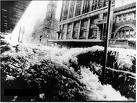Melbourne has experienced two earthquakes in recent weeks. They tell us that it’s due to geological activity around Korumburra, but don’t believe a word of it. It’s not an earthquake: instead, it’s the sound of the Port Phillip fathers turning in their graves as they hear of a proposal to return Elizabeth Street in Melbourne to a creek bed.
The Age on Saturday invited a number of Melbourne worthies to respond to the question “What would you do for this city if you could?” releasing them from those pesky considerations of economic and political constraints. Gilbert Rochecouste, described as a “planning mastermind” (who has escaped my radar completely, but apparently he’s the man who led the rejuvenation of Melbourne’s laneways), suggested opening up the concrete on Elizabeth Street and letting Williams Creek underneath flow free.
Actually, I hadn’t heard it referred to as “Williams Creek” before, but William Westgarth’s recollections confirm that it was previously known by this name. The people of early Melbourne had other names for it too- “a jungly chasm” is particularly evocative. The corner of Collins and Elizabeth Street seems to have been particularly treacherous. Thomas Strode the newspaperman recalled in 1868
At almost every hour of the day may be viewed the interesting spectacle of drays being bogged in the muddy depths of Collins-street…We remember on [one] occasion a dray of bullocks were so hopelessly imbedded in a hole in Elizabeth-street, that the animals were allowed to stifle in the mud, and its being nobody’s duty to remove the nuisance, their remains with that of the dray, lie buried in that extemporary graveyard to the present day. (cited in Annear p. 41)
Perhaps the reclamation of “Williams Creek” may uncover them! It was obviously a pretty boggy area. Apart from Williams Creek, two other tributaries ran into Yarra. “River Townend” which ran from the corner of Collins and Elizabeth Streets was named after Michael Townend, the ‘fat, comfortable-looking grocer’ on the south-west corner. “River Enscoe” ran from the north-west corner of William and Flinders street, and was named for the merchant John Enscoe who very nearly drowned in it.
Each winter “Lake Cashmore” would form on the doorstep of Michael Cashmore the draper who owned the shop on the northeast “Block” corner of Collins and Elizabeth Streets, described by Garryowen as “a large pool of stagnant water, not sufficiently deep to drown a man, but quite sufficient to half do it. ” (Garryowen p. 457)
During downpours of rain, litter from the surrounding streets would pour into Elizabeth Street gully:
Pieces of timber, wisps of straw, waste paper, and corks, as they are borne past and beyond carpenter’s shops, stable yards, printing offices, or hotels, sufficiently indicate the character of the neighbourhoods from which they have been carried; corks come down into the main stream from every side. From all the ‘rights-of-way’ they pour in crowds. They rush out of the lower slums of Little Bourke Street, and from both ends of every street in the town, until they collect in a dense mass in the wide space between Collins Street and Flinders Lane, where they form a closely-packed army of bobbing bedouins… (cited Brown-May, p. 75)
Somehow the ‘bobbing bedouins’ of wine and champagne corks is a quainter image than a congealed mass of Big Mac wrappers. Melburnians of a certain age will remember when Elizabeth Street flooded in 1972: looking back, it seems remarkable that no-one drowned given the number of basement shops and subways there.

When the ravine was in full flood during the early years, the only safe place to cross it was at Lonsdale Street. In 1880s Elizabeth Street became one of the first stormwater drains, carrying water from Carlton down to the river. In the Stork Hotel at the top of Elizabeth Street (much loved for the late Dennis Prior’s dramatizations of the Greek myths), there used to be a series of photographs on the wall showing the raising of Elizabeth Street so that what had previously been the street-level bar became the basement.
All that engineering; all that technology! What would the city fathers say?
Well, actually, one of them thought of it first. William Westgarth in his Personal Recollections of Early Melbourne wrote in 1888:
Melbourne missed a great chance in filling up with a street this troublesome, and as a street, unhealthy hollow… A reservation of the natural grass and gum-trees between Queen and Swanston street would have redeemed Melbourne up to the first rank of urban scenic effect and the riotous Williams might, with entire usefulness, have subsided into a succession of ornamental lakes and fish ponds.
Maybe all this earthquake activity is not the city fathers turning in their graves; perhaps it’s old Willie Westgarth slapping his knees and roaring with laughter that it has taken us 121 years to embrace his vision.
References:
Robyn Annear, Bearbrass: Imagining Early Melbourne, 1995
Andew Brown-May Melbourne Street Life 1998
Garryowen Chronicles of Early Melbourne
Kirsten Otto Yarra: A Diverting History of Melbourne’s Murky River, 2005
William Westgarth Personal Recollections of Early Melbourne (e-text)
